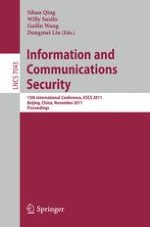This book constitutes the refereed proceedings of the 13th International Conference on Information and Communications Security, ICICS 2011, held in Beijing, China, in November 2011. The 33 revised full papers presented together with an invited talk were carefully reviewed and selected from 141 submissions. The papers are organized in topical sections on digital signatures, public key encryption, cryptographic protocols, applied cryptography, multimedia security, algorithms and evaluation, cryptanalysis, security applications, wireless network security, system security, and network security.
